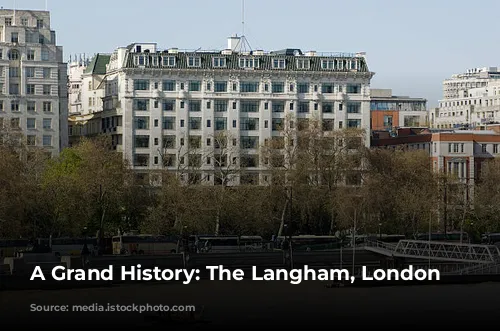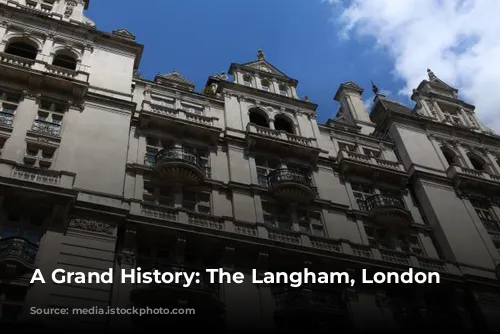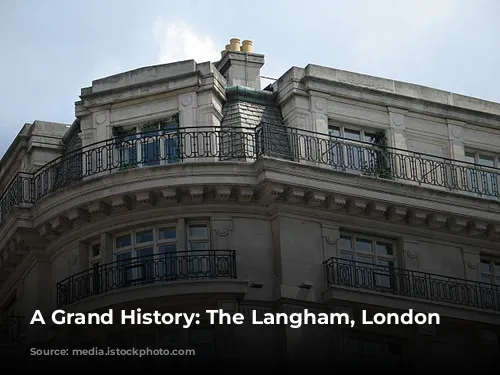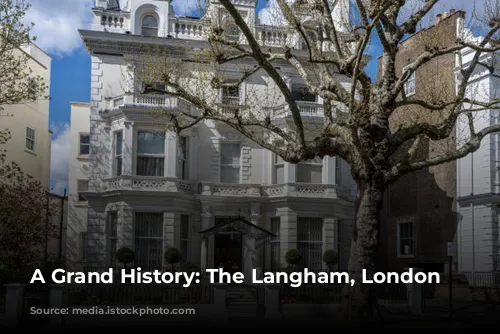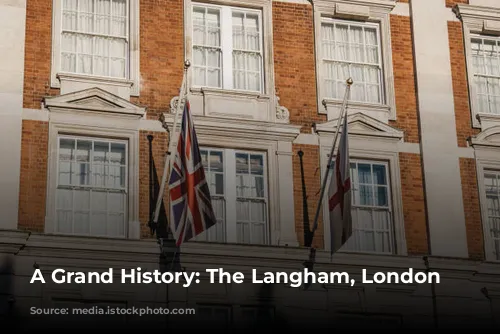Step into a world of elegance and history at The Langham, a five-star hotel gracing the heart of London. Nestled in the Marylebone district, this architectural masterpiece stands proudly on Langham Place, its gaze directed towards the verdant expanse of Regent’s Park.
The Langham’s story is woven with the threads of Victorian grandeur and modern innovation. Constructed between 1863 and 1865, this architectural marvel was the brainchild of John Giles and the skilled hands of Lucas Brothers. The project, costing a staggering £300,000 (equivalent to £36,230,425 in today’s currency), brought forth the city’s largest and most cutting-edge hotel. Imagine the wonder of a hundred water closets, thirty-six bathrooms, and the marvel of England’s first hydraulic lifts – all under one roof! The grand opening on June 10, 1865, was a spectacle, graced by the presence of the Prince of Wales himself.
A Hub of History and Glamour
The Langham’s rise to prominence was nothing short of remarkable. Despite a shaky start during an economic downturn, the hotel found its footing under new management. A pivotal moment arrived with the appointment of James Sanderson, an American veteran of the Union Army, as general manager in 1867. Sanderson’s influence attracted a wave of American clientele, including the legendary Mark Twain and the formidable financier Hetty Green. The Langham’s allure extended beyond the shores of America, captivating figures like Napoleon III, the flamboyant Oscar Wilde, and musical titans such as Dvorák, Toscanini, and Sibelius. The hotel’s embrace of modern advancements saw the installation of electric lighting in the entrance and courtyard as early as 1879. The Langham even played host to the literary genius of Arthur Conan Doyle, who set parts of his iconic Sherlock Holmes tales, “A Scandal in Bohemia” and “The Sign of Four,” within its walls.
Royalty, Politicians, and Stars
The Langham’s reputation as a sanctuary for the elite continued to flourish throughout the 20th century. Royalty, politicians, and celebrities alike sought refuge within its elegant walls. Diana, Princess of Wales, graced the hotel with her presence, as did Winston Churchill and Charles de Gaulle, titans of their respective fields. The list of luminaries who walked its corridors is a veritable who’s who of history and fame, including the charming Noël Coward, the enigmatic Wallis Simpson, the legendary cricketer Don Bradman, Emperor Haile Selassie of Ethiopia, and the pop icon Ayumi Hamasaki.
Trials and Triumphs
The Langham, like many grand institutions, faced its share of trials and tribulations. The Great Depression cast a long shadow, forcing the owners to consider selling the property to the BBC. Fate had other plans, as Broadcasting House was built across Portland Place instead. World War II brought a different kind of challenge. The hotel, used in part by the British Army, suffered damage from bomb attacks, forcing its temporary closure. The BBC, after using the hotel as auxiliary accommodation to Broadcasting House, acquired it outright in 1965.
From BBC Headquarters to Modern Glory
The Langham’s chapter as a BBC headquarters saw its Palm Court transformed into a reference library, and its restaurant into a staff bar and refreshment room. The BBC’s ambitious plan to demolish the building and replace it with a modern office development in 1980 met with resistance and ultimately failed. The Langham’s fate took a new turn in 1986 when the BBC sold it to the Ladbroke Group, who, after a substantial £100 million refurbishment, reopened it as the Langham Hilton in 1991.
A New Dawn for The Langham
The Langham’s story took another exciting turn in 1995 with the acquisition by Hong Kong-based Great Eagle Holdings. The new owners embarked on a series of renovations and expansions, transforming the hotel into a beacon of modern luxury. Extensive refurbishment between 1998 and 2000, followed by another significant makeover between 2004 and 2009, at an estimated cost of £80 million, restored the hotel to its original grandeur. The Langham’s legacy extended beyond its London home, with Great Eagle expanding its portfolio and creating a subsidiary, Langham Hotels International.

A Legacy of Luxury and Charm
Today, The Langham stands as a testament to its rich history and timeless elegance. With 380 beautifully appointed rooms, the hotel offers an array of amenities, including the restored Palm Court, a haven for afternoon tea since 1865. The Langham’s commitment to culinary excellence is evident in its diverse dining options. The newly opened Mimosa restaurant (replacing The Landau) promises a delightful culinary experience, while the nearby Wigmore, a British tavern from Michel Roux Jr., offers a taste of traditional British gastronomy. The hotel also boasts the Good Front Room, a popular long-term residency from Dom Taylor, the winner of the Five Star Kitchen TV show. Artesian, the hotel’s cocktail bar, and a private dining room cater to every taste.
The Langham’s commitment to excellence continues to shine with the opening of the Sauce by The Langham cookery school in 2019.
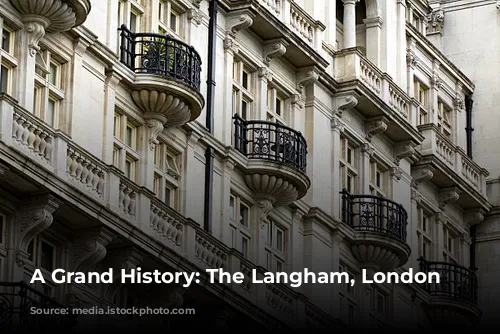
An Icon on the World Stage
The Langham’s allure has captivated the world beyond its elegant walls. It has graced the silver screen, appearing in James Bond’s “GoldenEye” (1995) and Michael Winterbottom’s “Wonderland” (1999). Its exterior played a starring role in Mary-Kate and Ashley Olsen’s “Winning London” (2001) and Garfield: A Tail of Two Kitties” (2006). The Langham’s restaurant served as the backdrop for the culinary drama “Burnt,” starring Bradley Cooper. In 2023, the Palm Court became the setting for the reality TV cooking show “Five Star Chef.”
The Langham’s legacy extends beyond the realm of film and television, even finding its way into the pages of literature. Felicia Kingsley’s novel “Prima Regola: Non Innamorarsi” features a scene set in the Palm Court. Jane Smiley’s novel “Lucky” (2024) features a chapter where the main character stays at The Langham.
The Langham, London, is not just a hotel; it is a living testament to history, a sanctuary of elegance, and a symbol of enduring luxury. From its Victorian origins to its modern-day grandeur, the Langham continues to captivate the hearts and imaginations of travelers from around the world.

